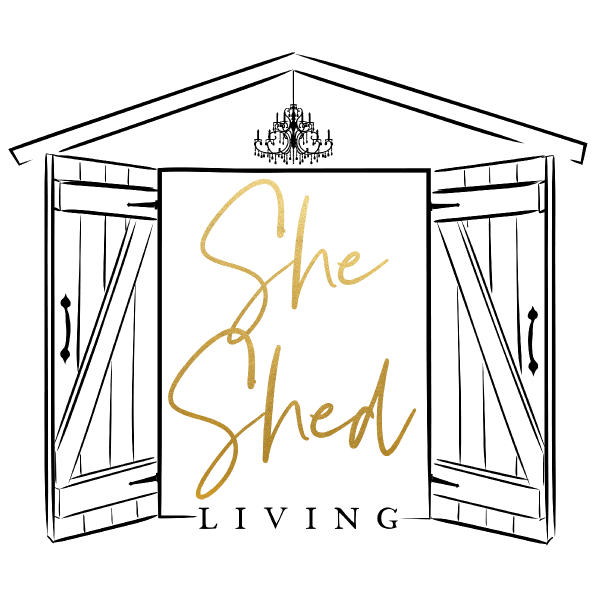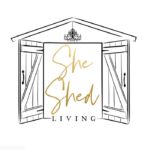The flooring in your shed is important both for design and functionality. There are many ways to create a gorgeous and long-lasting floor with sturdiness, eye appeal and comfort in mind. We’ll look at materials that include wood, vinyl and concrete/masonry.

(Disclosure: This post may contain affiliate links, meaning we get a commission if you decide to make a purchase through our links, at no cost to you. Please read our disclosure page for more info.)
The floor is the first thing you see and experience in a she shed. Because she sheds are integral components of a backyard landscape, they often rest on foundations that serve double duty as a floor. But you have many, many options for flooring from which to choose. The best she shed flooring for your needs depends on your use of the shed, where you live, your style and your budget.
For those of you in colder climates keep in mind that your she shed floor can also be a highly effective room warmer. Before installing your floor take a look at some of the low-profile radiant heat systems on the market, then get it in place before you seal the deal on your floor. Nice and cozy all year long! We will talk about the STEP HEAT system later on in this post.
Wood and Faux Wood Flooring
The most popular flooring for she sheds is wood. Wood floors are endlessly attractive and go well with the rusticity of a shed. Most of them are easy to install, too.
The most basic type of wood floor is actually a sub-floor, technically. You can use it as is without any finish floor covering on top. The sub-floor is usually made with plywood or osb panels, and it’s pretty bare bones. However, with a couple coats of your favorite paint and a lush area rug it is a perfectly good alternative to consider.

One step up from that would be using a variety of floor finishes on the market that give the look of wood, but are less expensive and often very easy to install. The two most common are wood-look ceramic tile planks and vinyl/laminate planks that interlock. Because they are discrete planks rather than a sheet, these flooring options mimic real wood much more closely. We’ve used these in some of our sheds and they have a nice, clean look. We also found this fun tile product that gives the look of a maple gymnasium floor.

A true wood floor is also a definite option and it is difficult to replicate the true warmth and texture of wood. Some of our shed floors have pine plank floor boards that are then stained or painted. They are installed over a sub floor and a good choice is tongue-and-groove planks for a solid, durable fit.
Decorative Floor Painting
Floor painting can add substantial color and drama to your shed. We are fortunate to know a world-class decorative painter, Shari Tipich, who designs and paints flooring (as well as walls, ceilings and murals) for clients throughout California. She paints on wood plank floors and can also paint on a uniform plywood floor. The results are awe-inspiring and this technique is highly recommended if you want to make a statement in your shed. Here are some of her designs.



You might consider laying your wood floor in a pattern such as parquet or herringbone, or even “faux” paint the look on flat wood. Again, decorative painters or practiced DIYers can make this happen with fabulous results. You can also use stencils, either by creating them yourself or purchasing them ready made. Etsy has some great selections.

Concrete and Brick Flooring
A concrete or brick floor in the she shed has a great bonus of being its foundation as well. This is a very common choice and it’s practical since you don’t have to build up (or pay for) a separate floor. Concrete and masonry are sturdy, level and can add an unpolished charm to the overall look of your shed.

When planning her ceramics studio design, Kim Brandstater knew that a concrete floor would work best with the classes and firings she would be doing there. To dress it up a bit, Kim added a lavender-blue tint to the concrete mix and also stamped a pretty “welcome mat” design into the wet concrete at the front door.
A brick foundation and floor looks terrific when it extends beyond the footprint of the shed to become a welcoming front patio, as seen here. Soften the interior with some well-placed area rugs.

Think Ahead to Stay Warm
Sponsored content Before installing your floor of choice, consider adding cozy radiant heat for those colder months. STEP Warmfloor by STEP HEAT is a nice option for she sheds, where space is limited and precious. The self-regulating radiant, electric underfloor heating elements gently warm from underneath and can be used under any non-conductive floor covering such as tile, hardwood, carpet, or laminate/vinyl. While other heating sources require floor space, ductwork and regular maintenance, this system works off low-voltage (12-48V), AC or DC. You can also connect it to a solar system. The STEP Warmfloor heating element is self-regulating and doesn’t overheat. It automatically reduces or increases its heat output to adjust to temperature changes.

The lightweight heating elements can be stapled or nailed to the sub floor and can be cut to length onsite; they are very thin and unobtrusive. (Note that you will need to add a finish covering over your sub floor to use this product.)The installation requires almost no floor buildup, uses less energy than traditional heat systems and doesn’t kick up dust in the air.

End sponsored content




My solution to flooring was to cut 6” wide planks of plywood and nail them on top of the plywood base. When painted or stained it really looks like wood planks!
What a terrific idea! Please send a photo to our email address: sheshedliving@gmail.com. We’d love to see your handiwork.